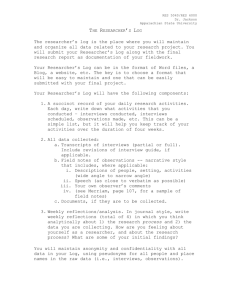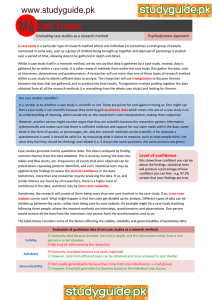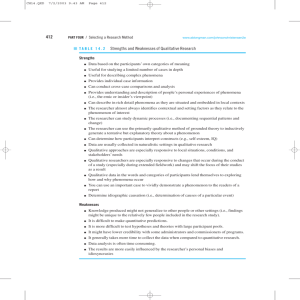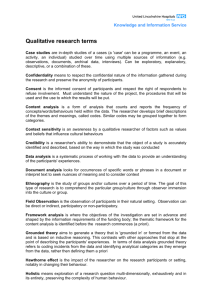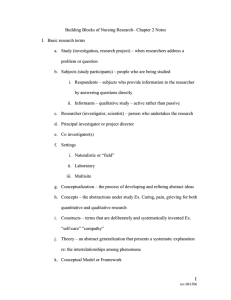Marketing research: defining the marketing research problem and
advertisement
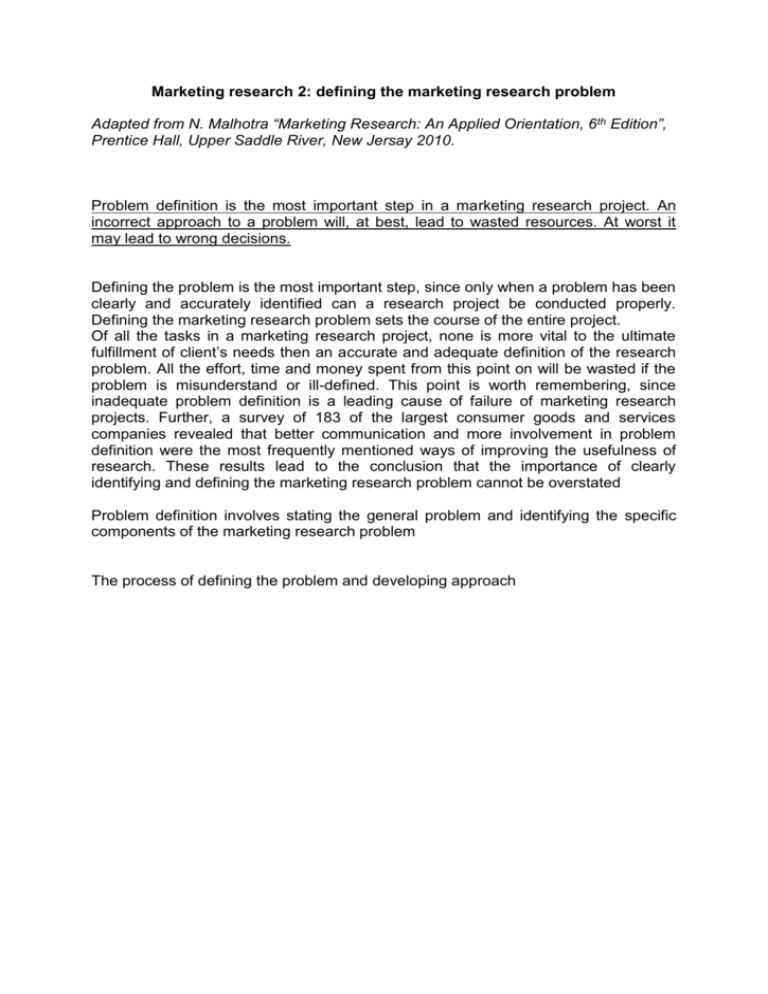
Marketing research 2: defining the marketing research problem Adapted from N. Malhotra “Marketing Research: An Applied Orientation, 6 th Edition”, Prentice Hall, Upper Saddle River, New Jersay 2010. Problem definition is the most important step in a marketing research project. An incorrect approach to a problem will, at best, lead to wasted resources. At worst it may lead to wrong decisions. Defining the problem is the most important step, since only when a problem has been clearly and accurately identified can a research project be conducted properly. Defining the marketing research problem sets the course of the entire project. Of all the tasks in a marketing research project, none is more vital to the ultimate fulfillment of client’s needs then an accurate and adequate definition of the research problem. All the effort, time and money spent from this point on will be wasted if the problem is misunderstand or ill-defined. This point is worth remembering, since inadequate problem definition is a leading cause of failure of marketing research projects. Further, a survey of 183 of the largest consumer goods and services companies revealed that better communication and more involvement in problem definition were the most frequently mentioned ways of improving the usefulness of research. These results lead to the conclusion that the importance of clearly identifying and defining the marketing research problem cannot be overstated Problem definition involves stating the general problem and identifying the specific components of the marketing research problem The process of defining the problem and developing approach Tasks involved Discussions with decision makers Interviews with experts Secondary data analysis Qualitative research Environmental context of the problem Step 1: Problem definition Management decision problem Marketing research problem Step 2: Approach to the problem Theoretical framework Analytical model: verbal, graphical or mathematical Research questions Hypotheses Characteristics/ factors influencing research design Step 3: Research design The purposes of the tasks involved in problem definition are to obtain information on the environmental context and to help define the marketing research problem. Discussions with the decision makers are extremely important. The DM needs to understand the capabilities and limitations of research. Research provides information relevant to management decisions, but it cannot provide solutions, because solutions require managerial judgment. Conversely, the researcher needs to understand the decision the managers face – the management problem – and what they hope to learn from the research. To identify the management problem, the researcher must posses considerable skill in interacting with the DM. Several factors may complicate this interaction. Access to the DM may be difficult, and some organizations have complicated protocols for access to top executives. The organizational status of the researcher or the research department may make it difficult to reach the key DM in the early stages of the project. Finally, there may be more then one key DM and meeting collectively or individually may be difficult. Despite these problems, it is necessary that the researcher interacts directly with the key decision makers. To comprehensively examine a marketing problem researchers need to discuss with the decision makers on the following topics: 1. The events that led to the decision that action is needed, or the history of the problem. 2. The alternative courses of action available to the DM. The set of alternatives may be incomplete at this stage, and qualitative research may be needed to identify the more innovative courses of action 3. The criteria that will be used to evaluate the alternative courses of action. For example, new product offerings might be evaluated on the basis of sales, market share, profitability, return on investment, and so forth. 4. The information needed to answer DM’s questions. 5. The manner in which the DM will use each item of information in making the decision. 6. The corporate culture as it relates to decision making. In some firms, the decision-making process is dominant; in others the personality of DM is more important. Awareness of corporate culture may be one of the most important factors that distinguish researchers who affect strategic marketing decisions from those who do not. DMs tend to focus on symptoms rather then the causes. Inability to meet sales forecasts, loss of market share, and decline in profits are all symptoms. For example, loss of market share may be caused by a superior promotion by the competition, inadequate distribution of the company’s products, or any number of other factors. Only when the underlying causes are identified can the problem be successfully addressed. In addition to discussions with the DM, interviews with industry experts, individuals knowledgeable about the firm and the industry, may help formulate the marketing research problem. These experts may be found both inside and outside the firm. Typically, expert information is obtained by unstructured personal interviews, without administering a formal questionnaire. The purpose of interviewing experts is to help define the marketing research problem rather then to develop a conclusive solution. Unfortunately, two potential difficulties may arise when seeking advice from experts: 1. Some individuals who claim to be knowledgeable and are eager to participate may not really possess expertise. 2. It may be difficult to locate and obtain the help from experts who are outside the client organization. Secondary data are data collected for some purpose other then the problem at hand. Primary data, on the other hand, are originated by the researcher for the specific purpose of addressing the research problem. Secondary data are an economical and quick source of background information. Analysis of secondary data is an essential step in the problem definition process: primary data should not be collected until the available secondary data have been fully analyzed. Information obtained from the DM and industry experts, along with secondary data, may not be sufficient to define the research problem. Sometimes qualitative research must be undertaken to gain an understanding of the problem and its underlying factors. Qualitative research is unstructured, exploratory in nature, based on small samples, and may utilize popular qualitative techniques such as focus group interviews and depth interviews. Environmental context of the problem are the factors that have an impact on the definition of the marketing research problem including past information and forecasts, resources and constraints of the firm, objectives of the decision maker, buyer behavior, legal environment, economic environment, and marketing and technological skills of the firm. The management decision problem asks what the DM needs to do, whereas the marketing research problem asks what information is needed and how it can be best obtained. The management decision problem is action oriented. It is concerned with the possible actions the DM can take. How should the loss of market share be arrested? Should the market be segmented differently? Should a new product be introduced? Should the promotional budget be increased? In contrast, the marketing research problem is information oriented. It involves determining what information is needed and how that information can be obtained effectively and efficiently. Consider, for example, the loss of market share for a particular product line. The DM’s decision problem is how to recover this loss. Alternative courses of action include modifying existing products, introducing new products, changing other elements in the marketing mix, and segmenting the market. Suppose that the DM and the researcher believe that the problem is caused by inappropriate segmentation of the market and wanted research to provide information on the issue. The research problem would then become the identification and evaluation of an alternative basis for segmenting the market.
